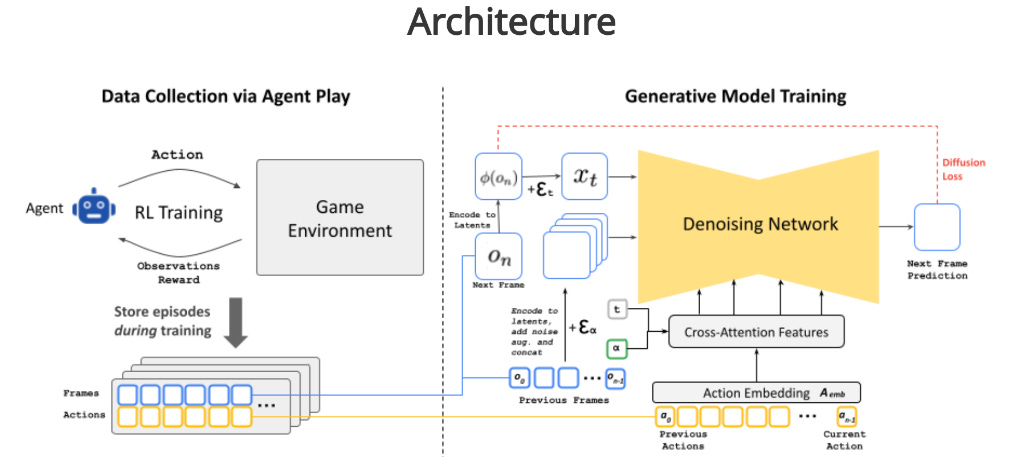AI-Driven Game Engines: How Neural Models Are Shaping the Future of Gaming
In March 2023, Jensen Huang, CEO of Nvidia, made a bold prediction: "In the future, every single pixel in a game will be generated, not rendered." Just over a year later, we’re witnessing the early stages of that future. This article explores a groundbreaking development in game technology—a neural model-powered game engine—using the classic game DOOM as a case study. This innovation isn't just a technological marvel; it's a potential game-changer for the entire gaming industry.
The Evolution of DOOM and Its Legacy
To understand the significance of AI-generated gaming, we need to start with a bit of history. DOOM, released in 1993 by id Software, revolutionized the gaming world with its advanced graphics and immersive gameplay. Developed primarily in the C programming language on NeXT computers, DOOM introduced players to a world of texture-mapped 3D environments, variable floor and ceiling heights, and innovative lighting effects, despite its 2.5D engine. The game’s assets were stored in WAD files ("Where's All the Data"), a format still used by the DOOM modding community today.
DOOM wasn’t just another game; it was a cultural phenomenon that laid the foundation for the first-person shooter genre. Its influence persists, with ongoing modding activities and even AI-driven experiments like the one we're discussing today.
Introducing Game Engine: The AI-Powered Future of Gaming
Fast forward to today, where a team of Google researchers has developed "GameNGen," the first game engine powered by a neural model. Unlike traditional game engines that render pre-determined frames, GameNGen generates each frame in real-time using a combination of reinforcement learning (RL) and diffusion models. This isn't just a visual simulation—it's an interactive, playable version of DOOM, where the AI generates every frame on the fly at 20 frames per second.
How Does GameNGen Work?
The core of GameNGen lies in its two-part architecture: an RL agent and a diffusion model. Here’s how these components work together:
1. Reinforcement Learning Agent (RL Agent): The first step was to train an RL agent to play DOOM. This agent had to play the game repeatedly to learn its rules and mechanics, similar to how AI has been trained to master chess or Super Mario Bros.
2. Stable Diffusion Model: For the visual aspect, the researchers trained a Stable Diffusion 1.4 model on DOOM’s graphics. Initial outputs were far from perfect—characters were smudged, and text was barely legible. However, with additional training, the model improved significantly, producing visuals that closely resemble the original DOOM.
3. World Model: To turn this into a fully interactive experience, the researchers integrated a world model. This AI environment understands the game world, predicting future events based on player interactions. For instance, if a player is about to shoot an enemy, the model prepares the corresponding animation in real-time. Unlike procedural generation, which algorithmically creates game content, the world model adapts dynamically to the player’s actions, creating a truly immersive experience.
The Challenges and Limitations
While GameNGen is a remarkable achievement, it's not without its limitations:
- Performance: Running at 20 FPS on a specialized Tensor Processing Unit (TPU), this is far from the smooth 60 FPS we expect from modern games. The technology is still in its infancy, and significant advancements are needed before it can compete with traditional game engines.
- Contextual Limitations: GameNGen can only store about three seconds of game context (approximately 64 frames). While it prioritizes essential game states like health and ammo, it’s prone to errors, especially during extended gameplay. Interestingly, these errors are more frequent when a human is playing rather than the AI agent, likely due to the unpredictable nature of human behavior.
- Accessibility: Currently, GameNGen is a research project, running on hardware that is far from consumer-grade. It’s not something you can run on your home PC, and it will likely be some time before this technology is accessible to the general public.
The Future of AI in Game Development
So, does AI DOOM signal a new era in gaming? Yes and no. Traditional game development pipelines will continue to dominate for the foreseeable future, with AI being used primarily to enhance existing workflows. However, GameNGen serves as proof of concept for a new branch of game development—one that could democratize the creation of games, making it more accessible to a broader audience.
While we’re not yet at the point where AI can generate entire open-world games like Skyrim, the rapid advancements we’ve seen, such as Google Genie's AI-generated side scrollers, suggest that we’re moving in that direction.
Why DOOM?
Finally, why was DOOM chosen for this experiment? The answer lies in its historical significance and technical simplicity. DOOM’s open-source implementation and low-resolution graphics made it an ideal candidate for this kind of cutting-edge research. Moreover, DOOM has been extensively studied by researchers and holds a special place in the hearts of many in the gaming community, including the team behind GameNGen.
AI-driven game engines like GameNGen represent a fascinating glimpse into the future of gaming. While the technology is still in its early stages, its potential is undeniable. As AI continues to evolve, we may soon see a new wave of games that are not just played but generated in real-time, offering players a level of immersion and interaction that was previously unimaginable.



